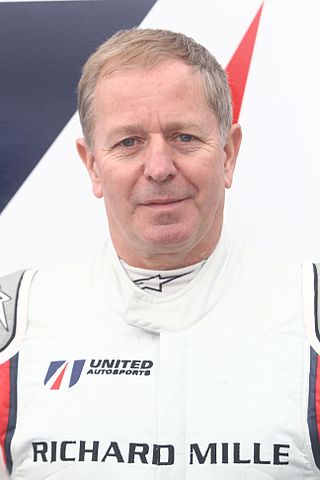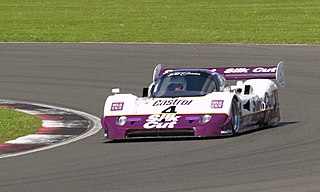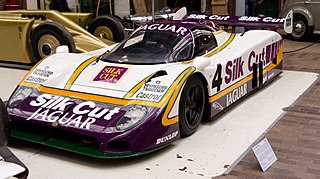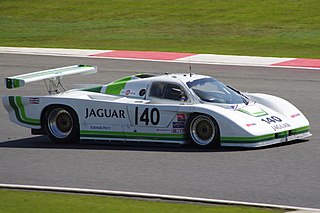
Martin John Brundle is a British former racing driver, best known as a Formula One driver and as a commentator for ITV Sport from 1997 to 2008, the BBC from 2009 to 2011, and Sky Sports since 2012.

The Jaguar XJ-S is a luxury grand tourer manufactured and marketed by British car manufacturer Jaguar Cars from 1975 to 1996, in coupé, fixed-profile and full convertible bodystyles. There were three distinct iterations, with a final production total of 115,413 units over 20 years and seven months.

Eliseo Salazar Valenzuela is a Chilean former racing driver. As of 2022, he is the only Chilean to have participated in a Formula One World Championship. He made his Formula One debut on 15 March 1981, and ultimately contested 37 races scoring a total of three championship points. After Formula One, Salazar has participated in numerous motorsport disciplines, including the Chilean national rally championship, Formula 3000, IndyCar, and the World Sportscar Championship.

The Jaguar XJ220 is a two-seat sports car produced by British luxury car manufacturer Jaguar from 1992 until 1994, in collaboration with the specialist automotive and race engineering company Tom Walkinshaw Racing. The XJ220 recorded a top speed of 212.3 mph (341.7 km/h) during testing by Jaguar at the Nardo test track in Italy. This made it the fastest production car from 1992 to 1993. According to Jaguar, an XJ220 prototype managed a Nürburgring lap time of 7:46.36 in 1991 which was faster than any production car lap time before it.

The Jaguar Sport XJR-15 is a two-seater sports car produced by JaguarSport, a subsidiary of Jaguar and Tom Walkinshaw Racing between 1990 and 1992. Only 50 were planned, each selling for £500,000.

The Sauber C9 is a Group C prototype race car introduced in 1987 as a continuation of the partnership between Sauber as a constructor and Mercedes-Benz as an engine builder for the World Sportscar Championship. The C9 replaced the Sauber C8.

Group C was a category of sports car racing introduced by the FIA in 1982 and continuing until 1993, with Group A for touring cars and Group B for GTs.
Tom Walkinshaw Racing (TWR) was a motor racing team and engineering firm founded in 1976, in Kidlington, near Oxford, England, by touring car racer Tom Walkinshaw.

The Jaguar XJR-9 is a sports-prototype race car built by Jaguar for both FIA Group C and IMSA Camel GTP racing, debuting at the 1988 24 Hours of Daytona.

The 1991 24 Hours of Le Mans was the 59th Grand Prix of Endurance, and took place on 22 and 23 June 1991. It was also the fourth round of the 1991 FIA Sportscar World Championship season.

The Jaguar XJR-14 is a sports-prototype racing car introduced for the 1991 World Sportscar Championship season. It was designed by Ross Brawn and John Piper, and was built and run by Tom Walkinshaw Racing (TWR), on behalf of Jaguar Cars.
The 1988 World Sportscar Championship season was the 36th season of FIA World Sportscar Championship motor racing. It featured the 1988 FIA World Sports Prototype Championship which was open to FIA Group C and Group C2 cars and to IMSA GTP, GTX, GTO and GTU cars. The championship was contested over an eleven race series which ran from 6 March to 20 November 1988.

The Mazda MXR-01 is a Group C sports prototype that was used by Mazda's factory team Mazdaspeed in the 1992 World Sportscar Championship season. It would be the final Mazda entry in sports car racing since the inception of its Le Mans project in 1983. It was based on the Jaguar XJR-14.

The Jaguar XJR sportscars were a series of race cars used by Jaguar-backed teams in both the World Sportscar Championship (WSC) Group C and the IMSA Camel GTP series between 1984 and 1993.

The Jaguar XJR-11 was a sports-prototype racing car introduced for the 1989 World Sports Prototype Championship, while its sister car the XJR-10 was introduced to compete in IMSA series races.

John Marshall Watson, is a British former racing driver and current commentator from Northern Ireland. He competed in Formula One, winning five Grands Prix and was third in the 1982 championship. He also competed in the World Sportscar Championship finishing second in the 1987 championship. After his retirement from motorsport, he became a commentator for Eurosport's coverage of Formula One from 1989 to 1996. He currently commentates on the GT World Challenge Europe and commentated on the 2022 Miami F1 Grand Prix for F1TV.

The XJR-8 was a race car built by Jaguar for campaigning in the World Sportscar Championship and the 24 Hours of Le Mans as part of Group C. It was used during the 1987 season.

The Jaguar XJR-10 is an IMSA GTP sports prototype race car, designed, developed, and built by TWR for Jaguar, with the aim of competing, from 1989, in the IMSA GT Championship. Jaguar XJR-10s competed until 1991, before Jaguar replaced it with the Jaguar XJR-16. The car debuted a new 3.0-liter twin-turbo V6 engine, which replaced the previous V12, and was later fitted to the Jaguar XJ220 as well.
The Jaguar XJR-17 was an IMSA Lights racing car, built by Tom Walkinshaw Racing. Rebuilt from a Jaguar XJR-16 for the IMSA Camel Lights, the XJR-17 never competed in the event due to funding issues and has since only been used in a few minor British events and historic races. It used a modified version of the XJR-16's 3.5-litre V6 engine, stripped of the twin-turbochargers and producing a claimed output of 450 hp, whilst its bodywork was cobbled together using various parts from older Jaguar XJR Sportscars.

The Jaguar XJR-5 is a IMSA GTP sports prototype race car, designed, developed and built by Group 44 racing for Jaguar with the aim of competing, from 1982, in the IMSA GT Championship. Jaguar XJR-5s contested until 1985, before Jaguar replaced it with the Jaguar XJR-7.


















